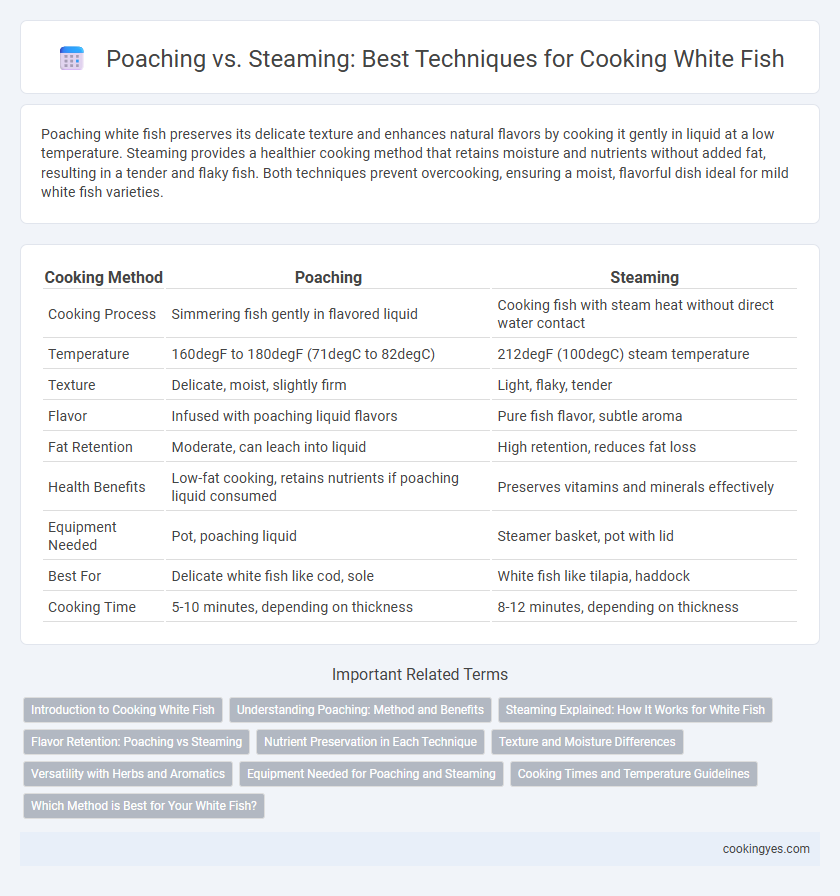Poaching white fish preserves its delicate texture and enhances natural flavors by cooking it gently in liquid at a low temperature. Steaming provides a healthier cooking method that retains moisture and nutrients without added fat, resulting in a tender and flaky fish. Both techniques prevent overcooking, ensuring a moist, flavorful dish ideal for mild white fish varieties.
Table of Comparison
| Cooking Method | Poaching | Steaming |
|---|---|---|
| Cooking Process | Simmering fish gently in flavored liquid | Cooking fish with steam heat without direct water contact |
| Temperature | 160degF to 180degF (71degC to 82degC) | 212degF (100degC) steam temperature |
| Texture | Delicate, moist, slightly firm | Light, flaky, tender |
| Flavor | Infused with poaching liquid flavors | Pure fish flavor, subtle aroma |
| Fat Retention | Moderate, can leach into liquid | High retention, reduces fat loss |
| Health Benefits | Low-fat cooking, retains nutrients if poaching liquid consumed | Preserves vitamins and minerals effectively |
| Equipment Needed | Pot, poaching liquid | Steamer basket, pot with lid |
| Best For | Delicate white fish like cod, sole | White fish like tilapia, haddock |
| Cooking Time | 5-10 minutes, depending on thickness | 8-12 minutes, depending on thickness |
Introduction to Cooking White Fish
Poaching white fish involves gently simmering the fillets in flavorful liquids like broth or wine, preserving moisture and delicate texture. Steaming cooks the fish through direct steam heat, maintaining natural flavors and nutrients without added fat. Both methods offer healthy, subtle cooking options ideal for tender white fish varieties such as cod, haddock, or sole.
Understanding Poaching: Method and Benefits
Poaching white fish involves gently cooking it in a simmering liquid such as water, broth, or wine at a controlled low temperature, which helps retain moisture and delicate flavors. This method is ideal for preserving the fish's tender texture and avoiding the dryness often associated with other cooking techniques. Nutrient retention is higher in poached fish compared to steaming, as the fish absorbs subtle flavors from the poaching liquid while maintaining its essential vitamins and minerals.
Steaming Explained: How It Works for White Fish
Steaming white fish involves cooking the fillets gently with hot steam, preserving moisture, tenderness, and delicate flavor. The technique uses a basket or rack above boiling water, ensuring even heat distribution without direct contact with water, which prevents nutrient loss. Steaming also maintains the fish's natural white color and flaky texture, making it a healthy, low-fat cooking method ideal for cod, haddock, and sole.
Flavor Retention: Poaching vs Steaming
Poaching white fish in a flavorful broth enhances moisture content and infuses subtle tastes, maintaining a delicate texture that highlights the natural sweetness of the fish. Steaming preserves the pure, clean flavor of white fish by using gentle, indirect heat that prevents overcooking and nutrient loss. Both methods excel in flavor retention, but poaching adds an extra savory dimension through the cooking liquid, while steaming offers a more neutral taste profile.
Nutrient Preservation in Each Technique
Steaming white fish retains more water-soluble vitamins like B-complex and minerals such as potassium compared to poaching, which can leach nutrients into the cooking liquid. Poaching involves submerging fish in flavored broth, potentially adding some nutrients but also causing loss of delicate proteins and omega-3 fatty acids due to longer exposure to heat. Steaming preserves the fish's natural texture and nutritional profile better by using moist heat without direct contact with water, ensuring optimal retention of essential nutrients.
Texture and Moisture Differences
Poaching white fish retains its delicate, flaky texture by cooking it gently in water or broth, ensuring maximum moisture and tenderness. Steaming also preserves moisture but results in a firmer, more structured flesh due to the indirect heat exposure. The choice between poaching and steaming affects the fish's juiciness and mouthfeel, with poaching offering a softer, moister bite compared to the slightly drier texture from steaming.
Versatility with Herbs and Aromatics
Steaming white fish preserves delicate flavors and allows herbs like dill, thyme, and parsley to infuse gently, enhancing the dish's aromatic profile without overpowering the natural taste. Poaching offers a versatile cooking method where the fish absorbs the subtle nuances of aromatics such as bay leaves, garlic, and lemon slices, creating a tender texture and layered flavors. Both techniques enable culinary creativity with herbs and spices, making them ideal for highlighting the fish's freshness and versatility.
Equipment Needed for Poaching and Steaming
Poaching white fish requires a shallow pan or skillet with a lid, filled with simmering liquid such as broth, water, or wine, and a stove to maintain gentle heat. Steaming white fish necessitates a steam basket or a dedicated steamer insert placed over boiling water, which allows the fish to cook evenly with moist heat, preserving its delicate texture. Both methods use minimal equipment, but steaming demands a specific setup for vapor circulation, while poaching relies on precise temperature control of the cooking liquid.
Cooking Times and Temperature Guidelines
Poaching white fish typically requires gentle cooking at temperatures between 160degF and 180degF, with cooking times ranging from 8 to 10 minutes per inch of thickness to maintain moisture and delicate texture. Steaming white fish involves temperatures around 212degF, shortening cooking times to about 6 to 8 minutes for similar thickness while preserving nutrients and flavor. Both methods prevent overcooking by closely monitoring internal temperatures, aiming for a flaky, opaque finish at an internal temperature of 140degF to 145degF.
Which Method is Best for Your White Fish?
Steaming preserves the delicate texture and natural moisture of white fish like cod, haddock, and sole, enhancing their mild flavor without added fat. Poaching gently cooks white fish in a flavorful liquid, such as broth or wine, infusing subtle tastes while maintaining tenderness and preventing drying. For lean white fish, steaming is ideal for retaining moisture, while poaching works best when aiming to incorporate additional flavors through the cooking liquid.
Poaching vs Steaming for Cooking White Fish Infographic

 cookingyes.com
cookingyes.com